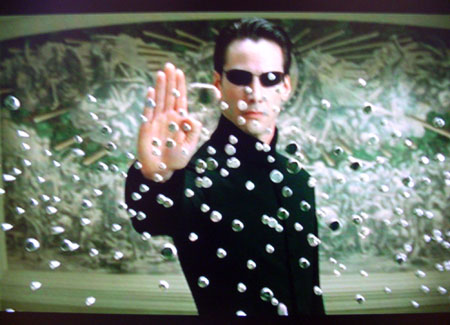The 20" LCD Shootout: Dell versus Apple
by Kristopher Kubicki on April 27, 2005 12:05 AM EST- Posted in
- Displays
Application Analysis
The core of our LCD benchmarking comes from real application analysis. We play with a lot of monitors and it gets easier for us each time to pick out problems with an LCD just by using the right application. Here are a few quick looks at some demanding full screen applications. We already ran ColorVision's OptiCal software, so all of our monitors are calibrated and adjusted to the same curves.High Definition Video – We played the WMV9 1080p and 720p versions of “Under Sea Adventure” to give our monitor a little taste of high definition video. In many of our previous analyses, we simply ran WMV9 content unscaled to test color depth and clarity. However, since both the Apple Cinema and Dell 2005FPW are capable of widescreen unscaled aspect ratios (at least for 720p), we thought it best to put both of these monitors completely through their paces. No surprise, but there doesn’t seem to be any corruption or shifts in any of the colors. However, keep in mind that neither of these displays supports HDCP! We could not watch 1080i or 720p signals on either display from a regular Comcast HD receiver, since neither display has a DVI-HDCP input. While pin compatible, any HDCP source simply terminates after a few seconds of video. The Dell 2005FPW has a few additional inputs, so we can actually use a component-to-VGA (15-pin D-sub) cable and watch HD content in this manner. Of course, for the same reason why we don’t encourage anyone to use 15-pin D-sub cables for regular computer use, we really don’t recommend D-sub for TV either if it can be avoided. Unfortunately, in this scenario, it cannot.
The Matrix Reload, The Matrix - We use the Matrix series to test full motion video on our LCDs. Since the Matrix isn't the best movie to test color reproduction, we typically only look for motion blur on gray-to-gray transitions or other imperfections in the signal. Both displays demonstrated accurate sharpness, although we noticed that the slightly duller Apple display had more of a “washed out” look to it in comparison to the Dell 2005FPW. Typically, we only see this on brighter LCDs with lower contrast ratios. Since the Apple 2005FPW has a (very) slight lower measured contrast ratio, this didn’t surprise us during out testing.
World of Warcraft – Although I didn’t personally start playing World of Warcraft until Anand published his Performance Guide, WOW happens to be one of the most perfect games to test LCD gaming. The fairly rich color palette, high motion objects and often contrasting lights and darks make the game a perfect haven to really put a display to its limits. (Unfortunately, once you turn it on, it also becomes nearly impossible to stop playing and start writing). Putting our displays into mirroring mode and playing for a few hours really stresses the importance of good color calibration in game settings; for example, it became almost impossible to differentiate portions of the grass needed to be selected for a quest on both LCDs before calibration through ColorVision’s OptiCal. Because both monitors were using DVI connectors, these changes had to be made to the color curves on the PC because the functionality is disabled on the monitors.
Max Payne 2 - The extreme light and dark transitions in Max Payne still provide us with the sufficient criteria to benchmark transient response time; specifically, we can focus on the light and dark extremes. We detected no red shift (as we usually do on this game for PVA displays), and had no problem with motion blur.
Photoshop CS – We typically don’t mention applications like Photoshop, but while using some of our new found desktop space, we took to advanced features in Photoshop like a fish in water. It’s no surprise that high end graphics (and, of course, video) are done on these displays; the higher resolution and wider room allow us to spread the tool bars out further while giving us more room to work. Widescreen displays feel awkward at first, but given hours of tinkering and readjusting, the additional room feels almost necessary.













70 Comments
View All Comments
sandys - Wednesday, April 27, 2005 - link
Oh yeah and as for panel manufacturer it can only be Samsung, not seen anyone else doing one. probably the ltm240w1http://www.samsung.com/Products/TFTLCD/common/prod...
pure guesswork of course :p
Gatak - Wednesday, April 27, 2005 - link
#36, It is about contrast. The eyes are strained if you have a bright light in just a part of the field of view. The strain comes from having to both adjust for the bright light _and_ at the same time allow enough light to come from the darker areas. In other words it is difficult for the eyes to properly acclimate to the lighting situation.sandys - Wednesday, April 27, 2005 - link
Hi JNo,The 2405 can be bought in the UK, for some reason it is not showing on Dells site but you can still phone them and buy it so answers to questions
a) yes it supports 1:1 pixel mapping
b) it can be bought but price varies depending on offer at the time, I bought two and got one half price plus 20% off bring each to £540 which was a bargain, others have got around 600-693 for a single unit.
c) yes it can.
The 2405 also has component and I run my PS2 and xbox off of it, unfortunately we get stiffed a bit in the UK and box Sony and MS remove the useful progressive resolutions in place of interlaced so the only way to get a quality output on Xbox is to mod it and switch it to NTSC and for the PS2 buy US games or live with 576i :(
look here www.hdtvarcade.com
Cheers
xsilver - Wednesday, April 27, 2005 - link
#31obviously to "fix" a dark room you just turn on the light... but I wanted to know more about the principles behind it.... what makes the monitor so different when its used in a dark room?
why is it so bad to turn down the brightness?
why does it hurt your eyes? (cause it doesnt hurt mine)
Zak - Wednesday, April 27, 2005 - link
Doom3 and Trainz configs can also be edited to support 1680x1050.Zak
ir0nw0lf - Wednesday, April 27, 2005 - link
Don't forget that World of Warcraft natively supports 1680x1050!!bob661 - Wednesday, April 27, 2005 - link
#21I won't buy a LCD either, yet. I do have a Viewsonic VP201b (supposedly the same panel as the Dell 2001FP) and it was VERY good playing UT2004 and Doom 3. I'll wait for two more generations of LCD AND then I'll some more for those to come down into the $300 range for a 19 or 20".
DestruyaUR - Wednesday, April 27, 2005 - link
Will these new 23 and 30" samples you speak of have HDCP circuitry so they could actually be used as TVs?Gatak - Wednesday, April 27, 2005 - link
#9: Easy to fix. Increase ambient light in the room. It is usually never good to work in a dark room. The "White" on the screen should also be the same color temperature as the ambient light.TinyTeeth - Wednesday, April 27, 2005 - link
Great review, but you really should use a better camera... :X